Children's Literature Analysis: Family Theme in 'Looking for JJ' Essay
VerifiedAdded on 2023/04/19
|14
|6125
|212
Essay
AI Summary
This essay provides an analysis of the theme of family in Anne Cassidy's 'Looking for JJ,' a children's novel that revolves around a teenage girl accused of murdering a child. The essay discusses the protagonist's background, her attempts to reintegrate into society, and the impact of emotional negligence on her development. It explores how the novel portrays the social perception of juvenile criminals and evokes empathy for the protagonist. The analysis highlights the significance of family dynamics in shaping a child's behavior and the devastating psychological impact of emotional abandonment. The essay concludes that 'Looking for JJ' is a thought-provoking novel that raises important questions about child murder and the role of parenthood in a child's development. Desklib provides similar essays and study resources for students.
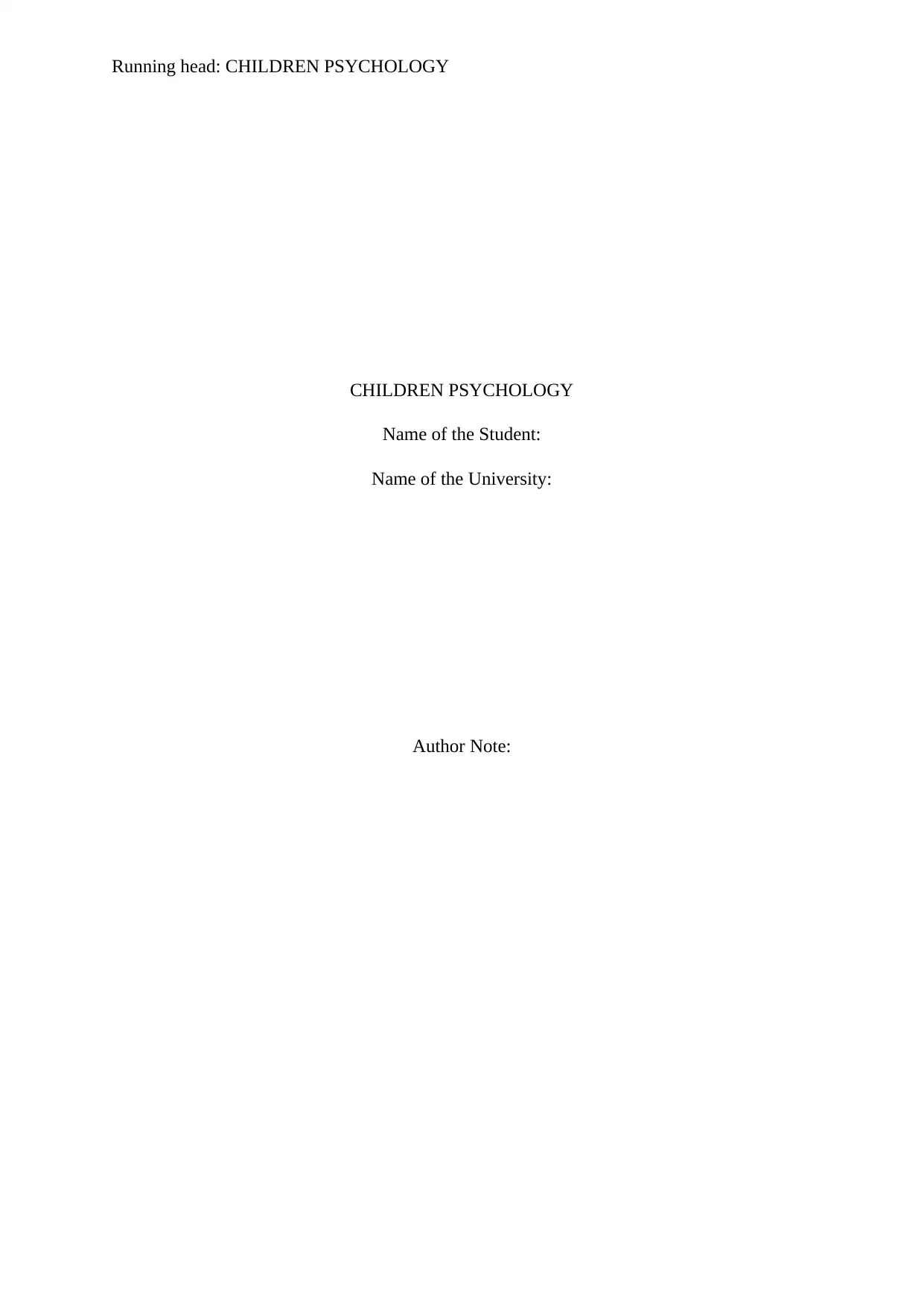
Running head: CHILDREN PSYCHOLOGY
CHILDREN PSYCHOLOGY
Name of the Student:
Name of the University:
Author Note:
CHILDREN PSYCHOLOGY
Name of the Student:
Name of the University:
Author Note:
Paraphrase This Document
Need a fresh take? Get an instant paraphrase of this document with our AI Paraphraser
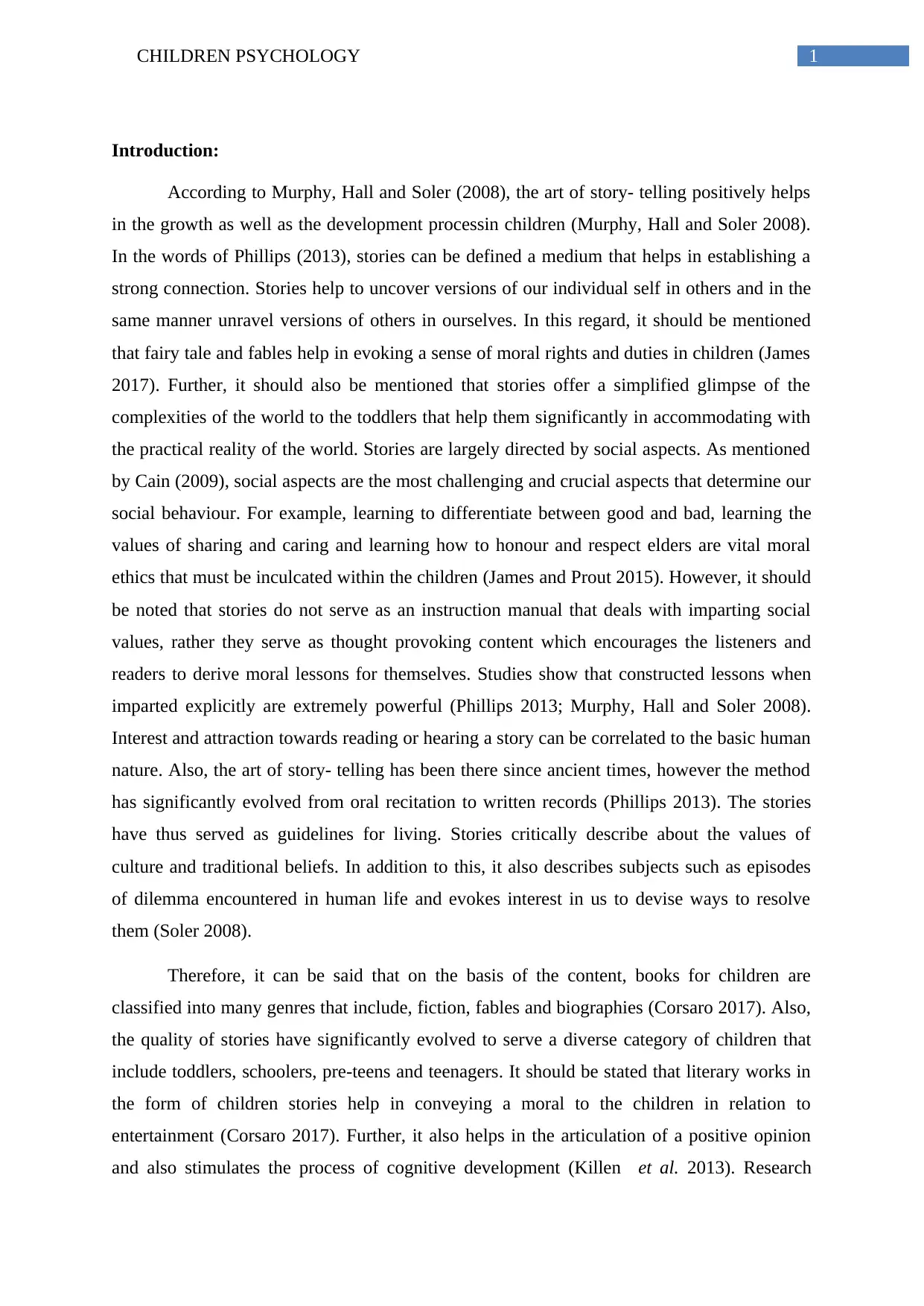
1CHILDREN PSYCHOLOGY
Introduction:
According to Murphy, Hall and Soler (2008), the art of story- telling positively helps
in the growth as well as the development processin children (Murphy, Hall and Soler 2008).
In the words of Phillips (2013), stories can be defined a medium that helps in establishing a
strong connection. Stories help to uncover versions of our individual self in others and in the
same manner unravel versions of others in ourselves. In this regard, it should be mentioned
that fairy tale and fables help in evoking a sense of moral rights and duties in children (James
2017). Further, it should also be mentioned that stories offer a simplified glimpse of the
complexities of the world to the toddlers that help them significantly in accommodating with
the practical reality of the world. Stories are largely directed by social aspects. As mentioned
by Cain (2009), social aspects are the most challenging and crucial aspects that determine our
social behaviour. For example, learning to differentiate between good and bad, learning the
values of sharing and caring and learning how to honour and respect elders are vital moral
ethics that must be inculcated within the children (James and Prout 2015). However, it should
be noted that stories do not serve as an instruction manual that deals with imparting social
values, rather they serve as thought provoking content which encourages the listeners and
readers to derive moral lessons for themselves. Studies show that constructed lessons when
imparted explicitly are extremely powerful (Phillips 2013; Murphy, Hall and Soler 2008).
Interest and attraction towards reading or hearing a story can be correlated to the basic human
nature. Also, the art of story- telling has been there since ancient times, however the method
has significantly evolved from oral recitation to written records (Phillips 2013). The stories
have thus served as guidelines for living. Stories critically describe about the values of
culture and traditional beliefs. In addition to this, it also describes subjects such as episodes
of dilemma encountered in human life and evokes interest in us to devise ways to resolve
them (Soler 2008).
Therefore, it can be said that on the basis of the content, books for children are
classified into many genres that include, fiction, fables and biographies (Corsaro 2017). Also,
the quality of stories have significantly evolved to serve a diverse category of children that
include toddlers, schoolers, pre-teens and teenagers. It should be stated that literary works in
the form of children stories help in conveying a moral to the children in relation to
entertainment (Corsaro 2017). Further, it also helps in the articulation of a positive opinion
and also stimulates the process of cognitive development (Killen et al. 2013). Research
Introduction:
According to Murphy, Hall and Soler (2008), the art of story- telling positively helps
in the growth as well as the development processin children (Murphy, Hall and Soler 2008).
In the words of Phillips (2013), stories can be defined a medium that helps in establishing a
strong connection. Stories help to uncover versions of our individual self in others and in the
same manner unravel versions of others in ourselves. In this regard, it should be mentioned
that fairy tale and fables help in evoking a sense of moral rights and duties in children (James
2017). Further, it should also be mentioned that stories offer a simplified glimpse of the
complexities of the world to the toddlers that help them significantly in accommodating with
the practical reality of the world. Stories are largely directed by social aspects. As mentioned
by Cain (2009), social aspects are the most challenging and crucial aspects that determine our
social behaviour. For example, learning to differentiate between good and bad, learning the
values of sharing and caring and learning how to honour and respect elders are vital moral
ethics that must be inculcated within the children (James and Prout 2015). However, it should
be noted that stories do not serve as an instruction manual that deals with imparting social
values, rather they serve as thought provoking content which encourages the listeners and
readers to derive moral lessons for themselves. Studies show that constructed lessons when
imparted explicitly are extremely powerful (Phillips 2013; Murphy, Hall and Soler 2008).
Interest and attraction towards reading or hearing a story can be correlated to the basic human
nature. Also, the art of story- telling has been there since ancient times, however the method
has significantly evolved from oral recitation to written records (Phillips 2013). The stories
have thus served as guidelines for living. Stories critically describe about the values of
culture and traditional beliefs. In addition to this, it also describes subjects such as episodes
of dilemma encountered in human life and evokes interest in us to devise ways to resolve
them (Soler 2008).
Therefore, it can be said that on the basis of the content, books for children are
classified into many genres that include, fiction, fables and biographies (Corsaro 2017). Also,
the quality of stories have significantly evolved to serve a diverse category of children that
include toddlers, schoolers, pre-teens and teenagers. It should be stated that literary works in
the form of children stories help in conveying a moral to the children in relation to
entertainment (Corsaro 2017). Further, it also helps in the articulation of a positive opinion
and also stimulates the process of cognitive development (Killen et al. 2013). Research
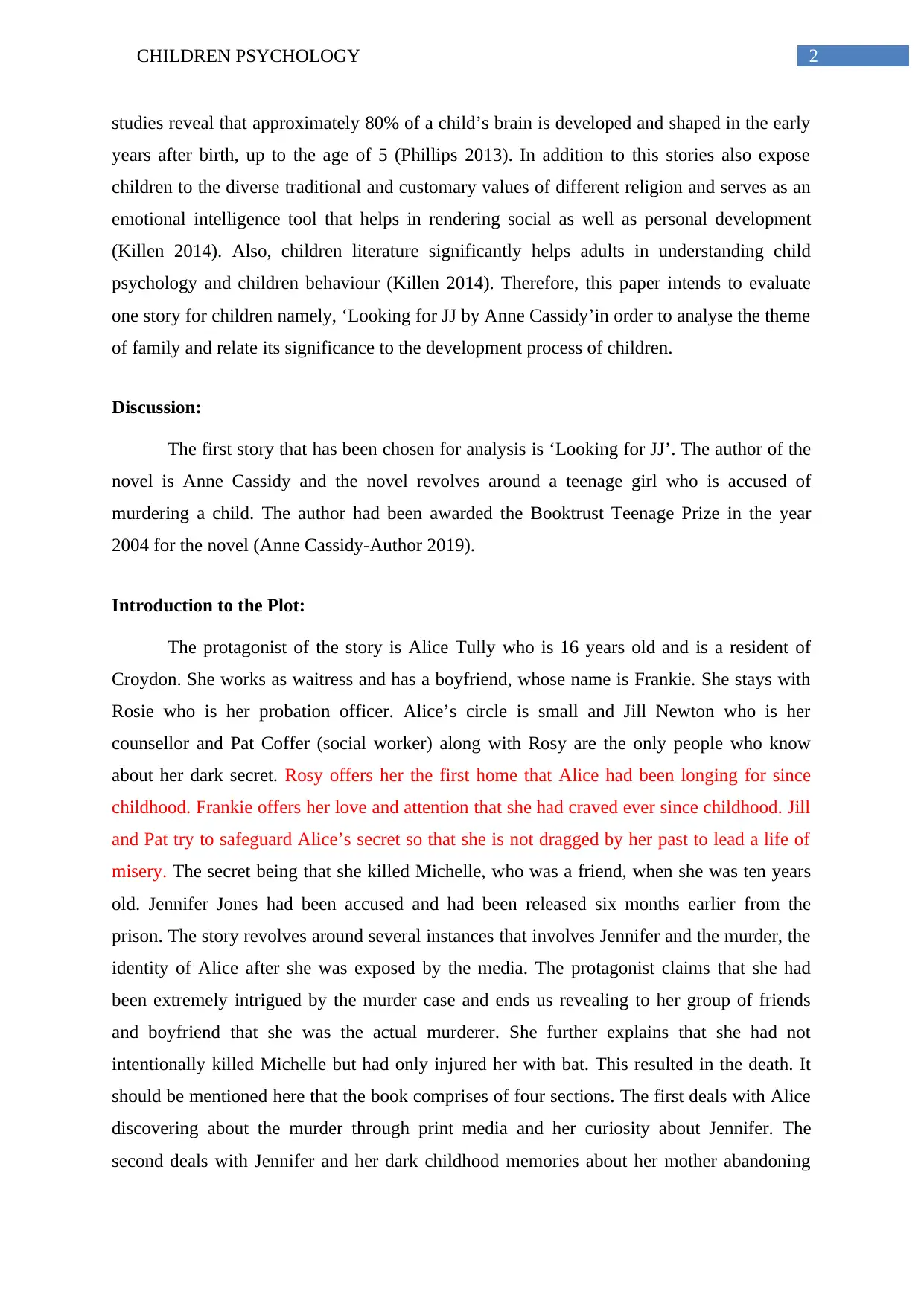
2CHILDREN PSYCHOLOGY
studies reveal that approximately 80% of a child’s brain is developed and shaped in the early
years after birth, up to the age of 5 (Phillips 2013). In addition to this stories also expose
children to the diverse traditional and customary values of different religion and serves as an
emotional intelligence tool that helps in rendering social as well as personal development
(Killen 2014). Also, children literature significantly helps adults in understanding child
psychology and children behaviour (Killen 2014). Therefore, this paper intends to evaluate
one story for children namely, ‘Looking for JJ by Anne Cassidy’in order to analyse the theme
of family and relate its significance to the development process of children.
Discussion:
The first story that has been chosen for analysis is ‘Looking for JJ’. The author of the
novel is Anne Cassidy and the novel revolves around a teenage girl who is accused of
murdering a child. The author had been awarded the Booktrust Teenage Prize in the year
2004 for the novel (Anne Cassidy-Author 2019).
Introduction to the Plot:
The protagonist of the story is Alice Tully who is 16 years old and is a resident of
Croydon. She works as waitress and has a boyfriend, whose name is Frankie. She stays with
Rosie who is her probation officer. Alice’s circle is small and Jill Newton who is her
counsellor and Pat Coffer (social worker) along with Rosy are the only people who know
about her dark secret. Rosy offers her the first home that Alice had been longing for since
childhood. Frankie offers her love and attention that she had craved ever since childhood. Jill
and Pat try to safeguard Alice’s secret so that she is not dragged by her past to lead a life of
misery. The secret being that she killed Michelle, who was a friend, when she was ten years
old. Jennifer Jones had been accused and had been released six months earlier from the
prison. The story revolves around several instances that involves Jennifer and the murder, the
identity of Alice after she was exposed by the media. The protagonist claims that she had
been extremely intrigued by the murder case and ends us revealing to her group of friends
and boyfriend that she was the actual murderer. She further explains that she had not
intentionally killed Michelle but had only injured her with bat. This resulted in the death. It
should be mentioned here that the book comprises of four sections. The first deals with Alice
discovering about the murder through print media and her curiosity about Jennifer. The
second deals with Jennifer and her dark childhood memories about her mother abandoning
studies reveal that approximately 80% of a child’s brain is developed and shaped in the early
years after birth, up to the age of 5 (Phillips 2013). In addition to this stories also expose
children to the diverse traditional and customary values of different religion and serves as an
emotional intelligence tool that helps in rendering social as well as personal development
(Killen 2014). Also, children literature significantly helps adults in understanding child
psychology and children behaviour (Killen 2014). Therefore, this paper intends to evaluate
one story for children namely, ‘Looking for JJ by Anne Cassidy’in order to analyse the theme
of family and relate its significance to the development process of children.
Discussion:
The first story that has been chosen for analysis is ‘Looking for JJ’. The author of the
novel is Anne Cassidy and the novel revolves around a teenage girl who is accused of
murdering a child. The author had been awarded the Booktrust Teenage Prize in the year
2004 for the novel (Anne Cassidy-Author 2019).
Introduction to the Plot:
The protagonist of the story is Alice Tully who is 16 years old and is a resident of
Croydon. She works as waitress and has a boyfriend, whose name is Frankie. She stays with
Rosie who is her probation officer. Alice’s circle is small and Jill Newton who is her
counsellor and Pat Coffer (social worker) along with Rosy are the only people who know
about her dark secret. Rosy offers her the first home that Alice had been longing for since
childhood. Frankie offers her love and attention that she had craved ever since childhood. Jill
and Pat try to safeguard Alice’s secret so that she is not dragged by her past to lead a life of
misery. The secret being that she killed Michelle, who was a friend, when she was ten years
old. Jennifer Jones had been accused and had been released six months earlier from the
prison. The story revolves around several instances that involves Jennifer and the murder, the
identity of Alice after she was exposed by the media. The protagonist claims that she had
been extremely intrigued by the murder case and ends us revealing to her group of friends
and boyfriend that she was the actual murderer. She further explains that she had not
intentionally killed Michelle but had only injured her with bat. This resulted in the death. It
should be mentioned here that the book comprises of four sections. The first deals with Alice
discovering about the murder through print media and her curiosity about Jennifer. The
second deals with Jennifer and her dark childhood memories about her mother abandoning
⊘ This is a preview!⊘
Do you want full access?
Subscribe today to unlock all pages.

Trusted by 1+ million students worldwide
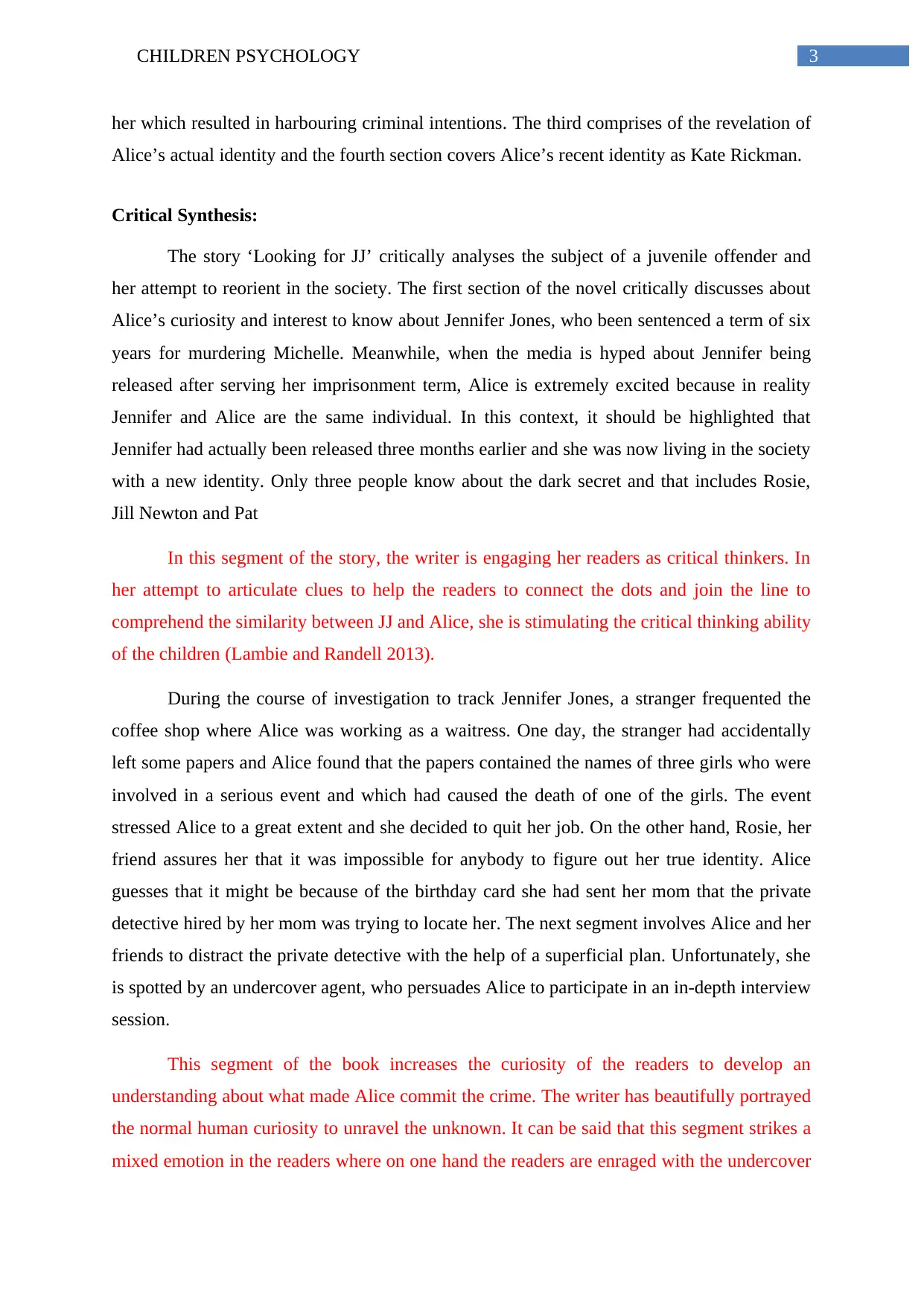
3CHILDREN PSYCHOLOGY
her which resulted in harbouring criminal intentions. The third comprises of the revelation of
Alice’s actual identity and the fourth section covers Alice’s recent identity as Kate Rickman.
Critical Synthesis:
The story ‘Looking for JJ’ critically analyses the subject of a juvenile offender and
her attempt to reorient in the society. The first section of the novel critically discusses about
Alice’s curiosity and interest to know about Jennifer Jones, who been sentenced a term of six
years for murdering Michelle. Meanwhile, when the media is hyped about Jennifer being
released after serving her imprisonment term, Alice is extremely excited because in reality
Jennifer and Alice are the same individual. In this context, it should be highlighted that
Jennifer had actually been released three months earlier and she was now living in the society
with a new identity. Only three people know about the dark secret and that includes Rosie,
Jill Newton and Pat
In this segment of the story, the writer is engaging her readers as critical thinkers. In
her attempt to articulate clues to help the readers to connect the dots and join the line to
comprehend the similarity between JJ and Alice, she is stimulating the critical thinking ability
of the children (Lambie and Randell 2013).
During the course of investigation to track Jennifer Jones, a stranger frequented the
coffee shop where Alice was working as a waitress. One day, the stranger had accidentally
left some papers and Alice found that the papers contained the names of three girls who were
involved in a serious event and which had caused the death of one of the girls. The event
stressed Alice to a great extent and she decided to quit her job. On the other hand, Rosie, her
friend assures her that it was impossible for anybody to figure out her true identity. Alice
guesses that it might be because of the birthday card she had sent her mom that the private
detective hired by her mom was trying to locate her. The next segment involves Alice and her
friends to distract the private detective with the help of a superficial plan. Unfortunately, she
is spotted by an undercover agent, who persuades Alice to participate in an in-depth interview
session.
This segment of the book increases the curiosity of the readers to develop an
understanding about what made Alice commit the crime. The writer has beautifully portrayed
the normal human curiosity to unravel the unknown. It can be said that this segment strikes a
mixed emotion in the readers where on one hand the readers are enraged with the undercover
her which resulted in harbouring criminal intentions. The third comprises of the revelation of
Alice’s actual identity and the fourth section covers Alice’s recent identity as Kate Rickman.
Critical Synthesis:
The story ‘Looking for JJ’ critically analyses the subject of a juvenile offender and
her attempt to reorient in the society. The first section of the novel critically discusses about
Alice’s curiosity and interest to know about Jennifer Jones, who been sentenced a term of six
years for murdering Michelle. Meanwhile, when the media is hyped about Jennifer being
released after serving her imprisonment term, Alice is extremely excited because in reality
Jennifer and Alice are the same individual. In this context, it should be highlighted that
Jennifer had actually been released three months earlier and she was now living in the society
with a new identity. Only three people know about the dark secret and that includes Rosie,
Jill Newton and Pat
In this segment of the story, the writer is engaging her readers as critical thinkers. In
her attempt to articulate clues to help the readers to connect the dots and join the line to
comprehend the similarity between JJ and Alice, she is stimulating the critical thinking ability
of the children (Lambie and Randell 2013).
During the course of investigation to track Jennifer Jones, a stranger frequented the
coffee shop where Alice was working as a waitress. One day, the stranger had accidentally
left some papers and Alice found that the papers contained the names of three girls who were
involved in a serious event and which had caused the death of one of the girls. The event
stressed Alice to a great extent and she decided to quit her job. On the other hand, Rosie, her
friend assures her that it was impossible for anybody to figure out her true identity. Alice
guesses that it might be because of the birthday card she had sent her mom that the private
detective hired by her mom was trying to locate her. The next segment involves Alice and her
friends to distract the private detective with the help of a superficial plan. Unfortunately, she
is spotted by an undercover agent, who persuades Alice to participate in an in-depth interview
session.
This segment of the book increases the curiosity of the readers to develop an
understanding about what made Alice commit the crime. The writer has beautifully portrayed
the normal human curiosity to unravel the unknown. It can be said that this segment strikes a
mixed emotion in the readers where on one hand the readers are enraged with the undercover
Paraphrase This Document
Need a fresh take? Get an instant paraphrase of this document with our AI Paraphraser
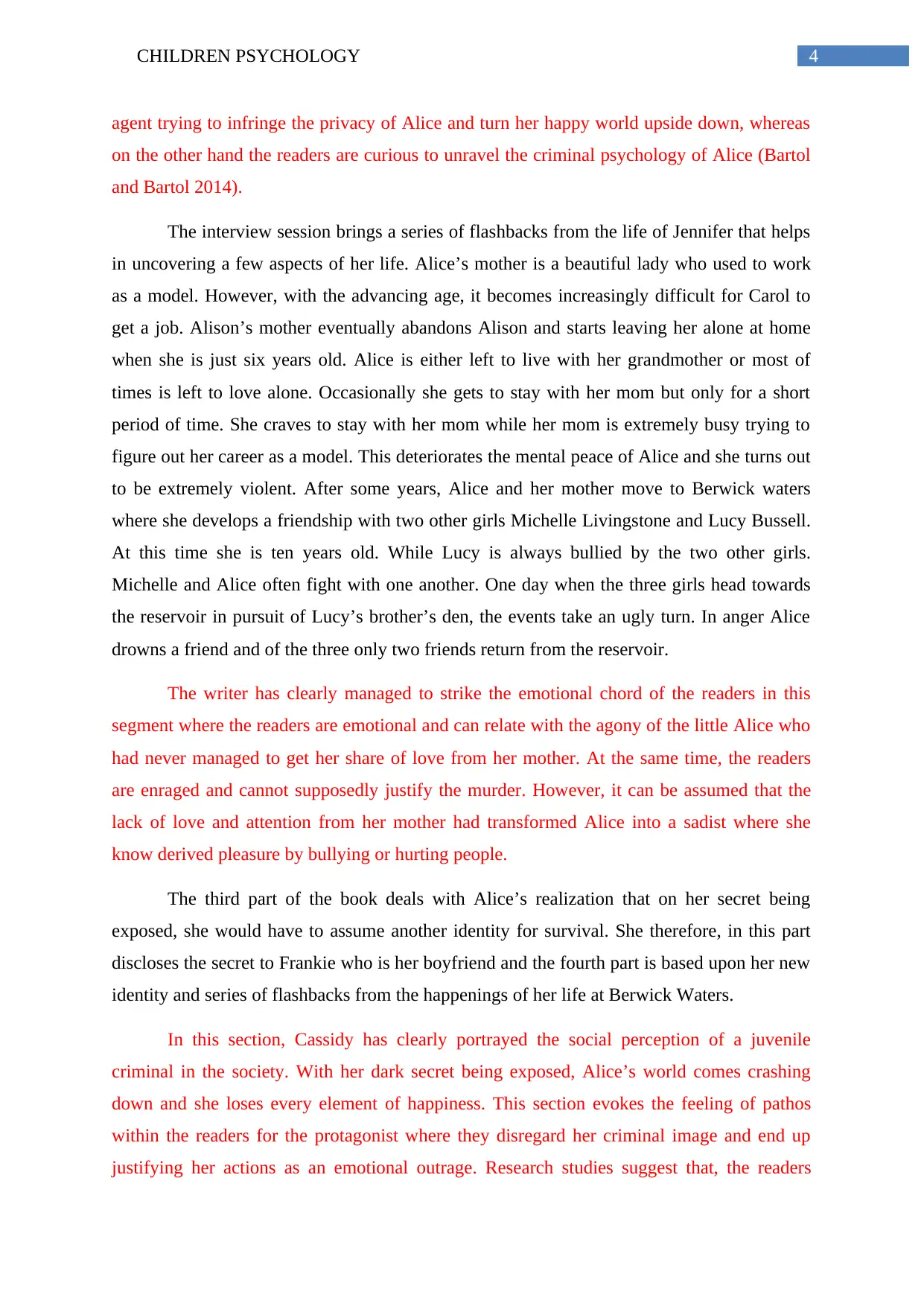
4CHILDREN PSYCHOLOGY
agent trying to infringe the privacy of Alice and turn her happy world upside down, whereas
on the other hand the readers are curious to unravel the criminal psychology of Alice (Bartol
and Bartol 2014).
The interview session brings a series of flashbacks from the life of Jennifer that helps
in uncovering a few aspects of her life. Alice’s mother is a beautiful lady who used to work
as a model. However, with the advancing age, it becomes increasingly difficult for Carol to
get a job. Alison’s mother eventually abandons Alison and starts leaving her alone at home
when she is just six years old. Alice is either left to live with her grandmother or most of
times is left to love alone. Occasionally she gets to stay with her mom but only for a short
period of time. She craves to stay with her mom while her mom is extremely busy trying to
figure out her career as a model. This deteriorates the mental peace of Alice and she turns out
to be extremely violent. After some years, Alice and her mother move to Berwick waters
where she develops a friendship with two other girls Michelle Livingstone and Lucy Bussell.
At this time she is ten years old. While Lucy is always bullied by the two other girls.
Michelle and Alice often fight with one another. One day when the three girls head towards
the reservoir in pursuit of Lucy’s brother’s den, the events take an ugly turn. In anger Alice
drowns a friend and of the three only two friends return from the reservoir.
The writer has clearly managed to strike the emotional chord of the readers in this
segment where the readers are emotional and can relate with the agony of the little Alice who
had never managed to get her share of love from her mother. At the same time, the readers
are enraged and cannot supposedly justify the murder. However, it can be assumed that the
lack of love and attention from her mother had transformed Alice into a sadist where she
know derived pleasure by bullying or hurting people.
The third part of the book deals with Alice’s realization that on her secret being
exposed, she would have to assume another identity for survival. She therefore, in this part
discloses the secret to Frankie who is her boyfriend and the fourth part is based upon her new
identity and series of flashbacks from the happenings of her life at Berwick Waters.
In this section, Cassidy has clearly portrayed the social perception of a juvenile
criminal in the society. With her dark secret being exposed, Alice’s world comes crashing
down and she loses every element of happiness. This section evokes the feeling of pathos
within the readers for the protagonist where they disregard her criminal image and end up
justifying her actions as an emotional outrage. Research studies suggest that, the readers
agent trying to infringe the privacy of Alice and turn her happy world upside down, whereas
on the other hand the readers are curious to unravel the criminal psychology of Alice (Bartol
and Bartol 2014).
The interview session brings a series of flashbacks from the life of Jennifer that helps
in uncovering a few aspects of her life. Alice’s mother is a beautiful lady who used to work
as a model. However, with the advancing age, it becomes increasingly difficult for Carol to
get a job. Alison’s mother eventually abandons Alison and starts leaving her alone at home
when she is just six years old. Alice is either left to live with her grandmother or most of
times is left to love alone. Occasionally she gets to stay with her mom but only for a short
period of time. She craves to stay with her mom while her mom is extremely busy trying to
figure out her career as a model. This deteriorates the mental peace of Alice and she turns out
to be extremely violent. After some years, Alice and her mother move to Berwick waters
where she develops a friendship with two other girls Michelle Livingstone and Lucy Bussell.
At this time she is ten years old. While Lucy is always bullied by the two other girls.
Michelle and Alice often fight with one another. One day when the three girls head towards
the reservoir in pursuit of Lucy’s brother’s den, the events take an ugly turn. In anger Alice
drowns a friend and of the three only two friends return from the reservoir.
The writer has clearly managed to strike the emotional chord of the readers in this
segment where the readers are emotional and can relate with the agony of the little Alice who
had never managed to get her share of love from her mother. At the same time, the readers
are enraged and cannot supposedly justify the murder. However, it can be assumed that the
lack of love and attention from her mother had transformed Alice into a sadist where she
know derived pleasure by bullying or hurting people.
The third part of the book deals with Alice’s realization that on her secret being
exposed, she would have to assume another identity for survival. She therefore, in this part
discloses the secret to Frankie who is her boyfriend and the fourth part is based upon her new
identity and series of flashbacks from the happenings of her life at Berwick Waters.
In this section, Cassidy has clearly portrayed the social perception of a juvenile
criminal in the society. With her dark secret being exposed, Alice’s world comes crashing
down and she loses every element of happiness. This section evokes the feeling of pathos
within the readers for the protagonist where they disregard her criminal image and end up
justifying her actions as an emotional outrage. Research studies suggest that, the readers
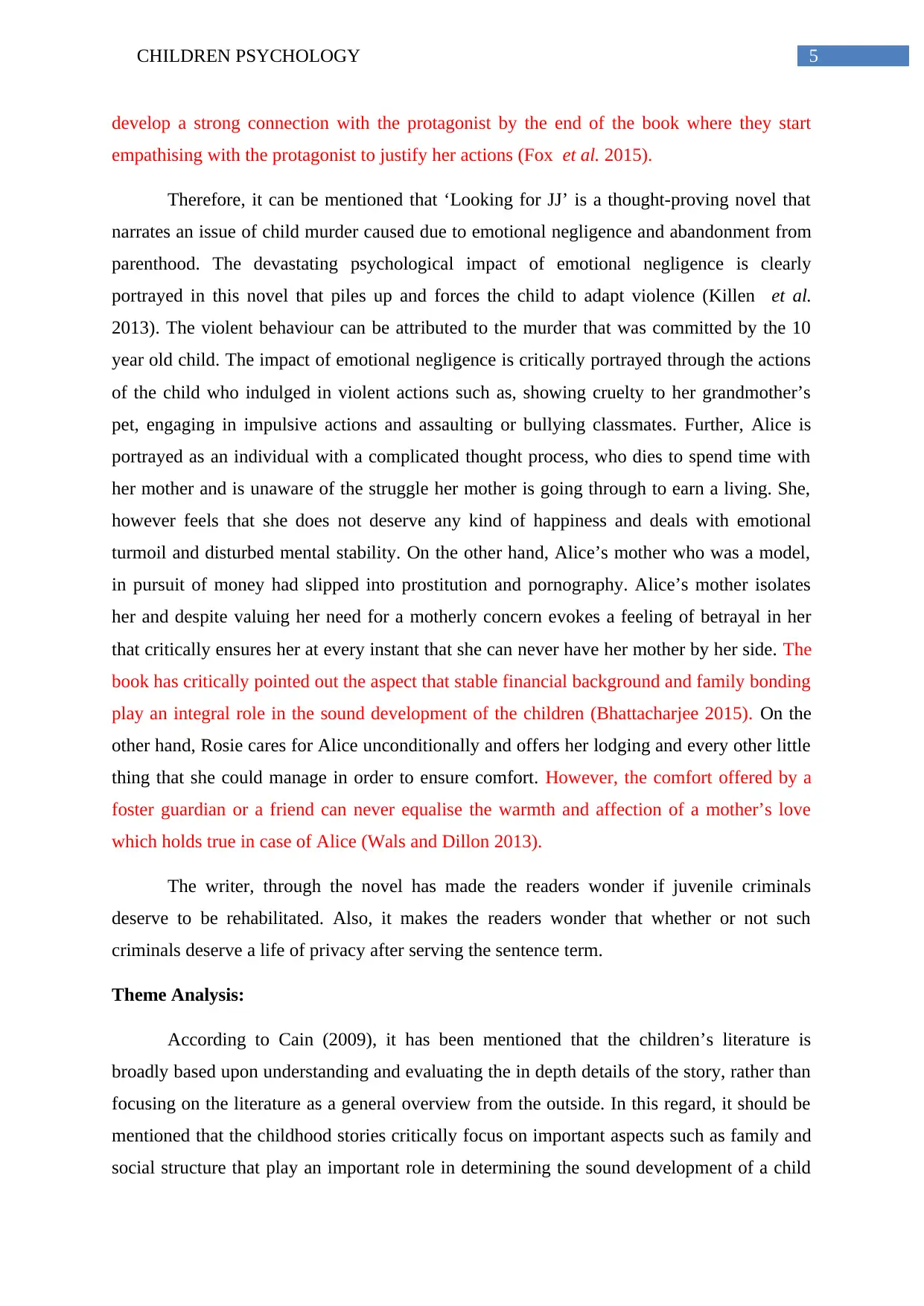
5CHILDREN PSYCHOLOGY
develop a strong connection with the protagonist by the end of the book where they start
empathising with the protagonist to justify her actions (Fox et al. 2015).
Therefore, it can be mentioned that ‘Looking for JJ’ is a thought-proving novel that
narrates an issue of child murder caused due to emotional negligence and abandonment from
parenthood. The devastating psychological impact of emotional negligence is clearly
portrayed in this novel that piles up and forces the child to adapt violence (Killen et al.
2013). The violent behaviour can be attributed to the murder that was committed by the 10
year old child. The impact of emotional negligence is critically portrayed through the actions
of the child who indulged in violent actions such as, showing cruelty to her grandmother’s
pet, engaging in impulsive actions and assaulting or bullying classmates. Further, Alice is
portrayed as an individual with a complicated thought process, who dies to spend time with
her mother and is unaware of the struggle her mother is going through to earn a living. She,
however feels that she does not deserve any kind of happiness and deals with emotional
turmoil and disturbed mental stability. On the other hand, Alice’s mother who was a model,
in pursuit of money had slipped into prostitution and pornography. Alice’s mother isolates
her and despite valuing her need for a motherly concern evokes a feeling of betrayal in her
that critically ensures her at every instant that she can never have her mother by her side. The
book has critically pointed out the aspect that stable financial background and family bonding
play an integral role in the sound development of the children (Bhattacharjee 2015). On the
other hand, Rosie cares for Alice unconditionally and offers her lodging and every other little
thing that she could manage in order to ensure comfort. However, the comfort offered by a
foster guardian or a friend can never equalise the warmth and affection of a mother’s love
which holds true in case of Alice (Wals and Dillon 2013).
The writer, through the novel has made the readers wonder if juvenile criminals
deserve to be rehabilitated. Also, it makes the readers wonder that whether or not such
criminals deserve a life of privacy after serving the sentence term.
Theme Analysis:
According to Cain (2009), it has been mentioned that the children’s literature is
broadly based upon understanding and evaluating the in depth details of the story, rather than
focusing on the literature as a general overview from the outside. In this regard, it should be
mentioned that the childhood stories critically focus on important aspects such as family and
social structure that play an important role in determining the sound development of a child
develop a strong connection with the protagonist by the end of the book where they start
empathising with the protagonist to justify her actions (Fox et al. 2015).
Therefore, it can be mentioned that ‘Looking for JJ’ is a thought-proving novel that
narrates an issue of child murder caused due to emotional negligence and abandonment from
parenthood. The devastating psychological impact of emotional negligence is clearly
portrayed in this novel that piles up and forces the child to adapt violence (Killen et al.
2013). The violent behaviour can be attributed to the murder that was committed by the 10
year old child. The impact of emotional negligence is critically portrayed through the actions
of the child who indulged in violent actions such as, showing cruelty to her grandmother’s
pet, engaging in impulsive actions and assaulting or bullying classmates. Further, Alice is
portrayed as an individual with a complicated thought process, who dies to spend time with
her mother and is unaware of the struggle her mother is going through to earn a living. She,
however feels that she does not deserve any kind of happiness and deals with emotional
turmoil and disturbed mental stability. On the other hand, Alice’s mother who was a model,
in pursuit of money had slipped into prostitution and pornography. Alice’s mother isolates
her and despite valuing her need for a motherly concern evokes a feeling of betrayal in her
that critically ensures her at every instant that she can never have her mother by her side. The
book has critically pointed out the aspect that stable financial background and family bonding
play an integral role in the sound development of the children (Bhattacharjee 2015). On the
other hand, Rosie cares for Alice unconditionally and offers her lodging and every other little
thing that she could manage in order to ensure comfort. However, the comfort offered by a
foster guardian or a friend can never equalise the warmth and affection of a mother’s love
which holds true in case of Alice (Wals and Dillon 2013).
The writer, through the novel has made the readers wonder if juvenile criminals
deserve to be rehabilitated. Also, it makes the readers wonder that whether or not such
criminals deserve a life of privacy after serving the sentence term.
Theme Analysis:
According to Cain (2009), it has been mentioned that the children’s literature is
broadly based upon understanding and evaluating the in depth details of the story, rather than
focusing on the literature as a general overview from the outside. In this regard, it should be
mentioned that the childhood stories critically focus on important aspects such as family and
social structure that play an important role in determining the sound development of a child
⊘ This is a preview!⊘
Do you want full access?
Subscribe today to unlock all pages.

Trusted by 1+ million students worldwide
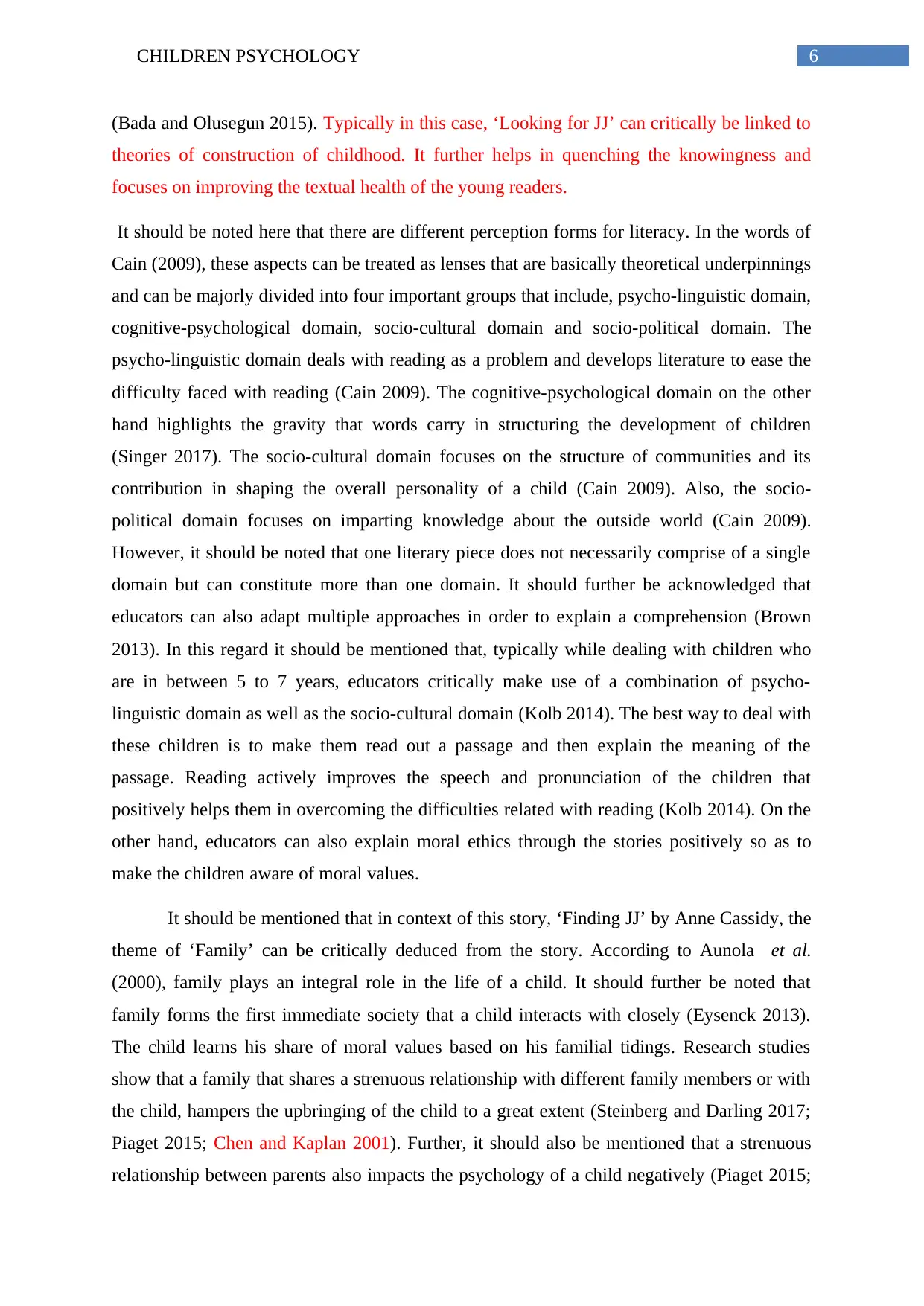
6CHILDREN PSYCHOLOGY
(Bada and Olusegun 2015). Typically in this case, ‘Looking for JJ’ can critically be linked to
theories of construction of childhood. It further helps in quenching the knowingness and
focuses on improving the textual health of the young readers.
It should be noted here that there are different perception forms for literacy. In the words of
Cain (2009), these aspects can be treated as lenses that are basically theoretical underpinnings
and can be majorly divided into four important groups that include, psycho-linguistic domain,
cognitive-psychological domain, socio-cultural domain and socio-political domain. The
psycho-linguistic domain deals with reading as a problem and develops literature to ease the
difficulty faced with reading (Cain 2009). The cognitive-psychological domain on the other
hand highlights the gravity that words carry in structuring the development of children
(Singer 2017). The socio-cultural domain focuses on the structure of communities and its
contribution in shaping the overall personality of a child (Cain 2009). Also, the socio-
political domain focuses on imparting knowledge about the outside world (Cain 2009).
However, it should be noted that one literary piece does not necessarily comprise of a single
domain but can constitute more than one domain. It should further be acknowledged that
educators can also adapt multiple approaches in order to explain a comprehension (Brown
2013). In this regard it should be mentioned that, typically while dealing with children who
are in between 5 to 7 years, educators critically make use of a combination of psycho-
linguistic domain as well as the socio-cultural domain (Kolb 2014). The best way to deal with
these children is to make them read out a passage and then explain the meaning of the
passage. Reading actively improves the speech and pronunciation of the children that
positively helps them in overcoming the difficulties related with reading (Kolb 2014). On the
other hand, educators can also explain moral ethics through the stories positively so as to
make the children aware of moral values.
It should be mentioned that in context of this story, ‘Finding JJ’ by Anne Cassidy, the
theme of ‘Family’ can be critically deduced from the story. According to Aunola et al.
(2000), family plays an integral role in the life of a child. It should further be noted that
family forms the first immediate society that a child interacts with closely (Eysenck 2013).
The child learns his share of moral values based on his familial tidings. Research studies
show that a family that shares a strenuous relationship with different family members or with
the child, hampers the upbringing of the child to a great extent (Steinberg and Darling 2017;
Piaget 2015; Chen and Kaplan 2001). Further, it should also be mentioned that a strenuous
relationship between parents also impacts the psychology of a child negatively (Piaget 2015;
(Bada and Olusegun 2015). Typically in this case, ‘Looking for JJ’ can critically be linked to
theories of construction of childhood. It further helps in quenching the knowingness and
focuses on improving the textual health of the young readers.
It should be noted here that there are different perception forms for literacy. In the words of
Cain (2009), these aspects can be treated as lenses that are basically theoretical underpinnings
and can be majorly divided into four important groups that include, psycho-linguistic domain,
cognitive-psychological domain, socio-cultural domain and socio-political domain. The
psycho-linguistic domain deals with reading as a problem and develops literature to ease the
difficulty faced with reading (Cain 2009). The cognitive-psychological domain on the other
hand highlights the gravity that words carry in structuring the development of children
(Singer 2017). The socio-cultural domain focuses on the structure of communities and its
contribution in shaping the overall personality of a child (Cain 2009). Also, the socio-
political domain focuses on imparting knowledge about the outside world (Cain 2009).
However, it should be noted that one literary piece does not necessarily comprise of a single
domain but can constitute more than one domain. It should further be acknowledged that
educators can also adapt multiple approaches in order to explain a comprehension (Brown
2013). In this regard it should be mentioned that, typically while dealing with children who
are in between 5 to 7 years, educators critically make use of a combination of psycho-
linguistic domain as well as the socio-cultural domain (Kolb 2014). The best way to deal with
these children is to make them read out a passage and then explain the meaning of the
passage. Reading actively improves the speech and pronunciation of the children that
positively helps them in overcoming the difficulties related with reading (Kolb 2014). On the
other hand, educators can also explain moral ethics through the stories positively so as to
make the children aware of moral values.
It should be mentioned that in context of this story, ‘Finding JJ’ by Anne Cassidy, the
theme of ‘Family’ can be critically deduced from the story. According to Aunola et al.
(2000), family plays an integral role in the life of a child. It should further be noted that
family forms the first immediate society that a child interacts with closely (Eysenck 2013).
The child learns his share of moral values based on his familial tidings. Research studies
show that a family that shares a strenuous relationship with different family members or with
the child, hampers the upbringing of the child to a great extent (Steinberg and Darling 2017;
Piaget 2015; Chen and Kaplan 2001). Further, it should also be mentioned that a strenuous
relationship between parents also impacts the psychology of a child negatively (Piaget 2015;
Paraphrase This Document
Need a fresh take? Get an instant paraphrase of this document with our AI Paraphraser
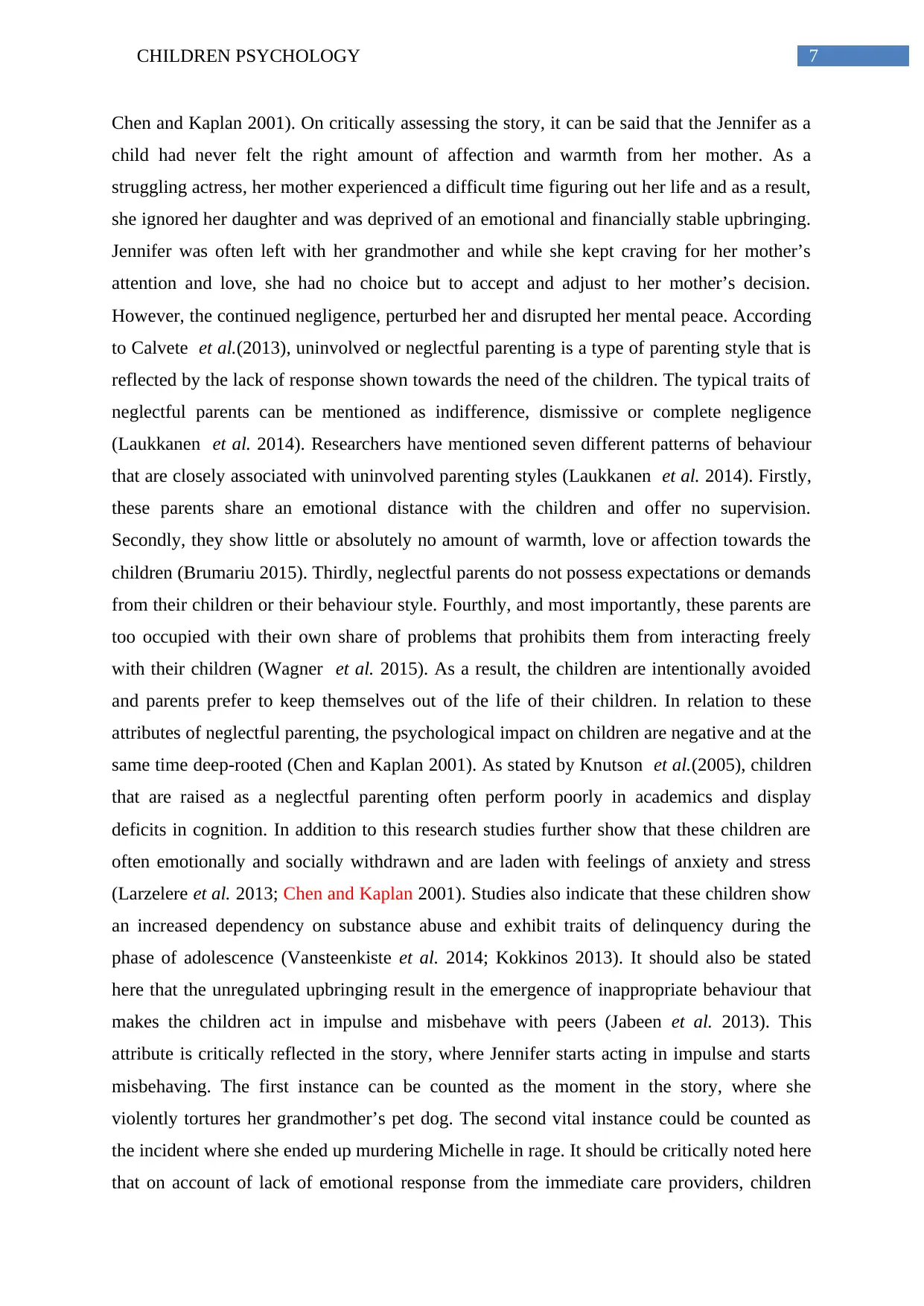
7CHILDREN PSYCHOLOGY
Chen and Kaplan 2001). On critically assessing the story, it can be said that the Jennifer as a
child had never felt the right amount of affection and warmth from her mother. As a
struggling actress, her mother experienced a difficult time figuring out her life and as a result,
she ignored her daughter and was deprived of an emotional and financially stable upbringing.
Jennifer was often left with her grandmother and while she kept craving for her mother’s
attention and love, she had no choice but to accept and adjust to her mother’s decision.
However, the continued negligence, perturbed her and disrupted her mental peace. According
to Calvete et al.(2013), uninvolved or neglectful parenting is a type of parenting style that is
reflected by the lack of response shown towards the need of the children. The typical traits of
neglectful parents can be mentioned as indifference, dismissive or complete negligence
(Laukkanen et al. 2014). Researchers have mentioned seven different patterns of behaviour
that are closely associated with uninvolved parenting styles (Laukkanen et al. 2014). Firstly,
these parents share an emotional distance with the children and offer no supervision.
Secondly, they show little or absolutely no amount of warmth, love or affection towards the
children (Brumariu 2015). Thirdly, neglectful parents do not possess expectations or demands
from their children or their behaviour style. Fourthly, and most importantly, these parents are
too occupied with their own share of problems that prohibits them from interacting freely
with their children (Wagner et al. 2015). As a result, the children are intentionally avoided
and parents prefer to keep themselves out of the life of their children. In relation to these
attributes of neglectful parenting, the psychological impact on children are negative and at the
same time deep-rooted (Chen and Kaplan 2001). As stated by Knutson et al.(2005), children
that are raised as a neglectful parenting often perform poorly in academics and display
deficits in cognition. In addition to this research studies further show that these children are
often emotionally and socially withdrawn and are laden with feelings of anxiety and stress
(Larzelere et al. 2013; Chen and Kaplan 2001). Studies also indicate that these children show
an increased dependency on substance abuse and exhibit traits of delinquency during the
phase of adolescence (Vansteenkiste et al. 2014; Kokkinos 2013). It should also be stated
here that the unregulated upbringing result in the emergence of inappropriate behaviour that
makes the children act in impulse and misbehave with peers (Jabeen et al. 2013). This
attribute is critically reflected in the story, where Jennifer starts acting in impulse and starts
misbehaving. The first instance can be counted as the moment in the story, where she
violently tortures her grandmother’s pet dog. The second vital instance could be counted as
the incident where she ended up murdering Michelle in rage. It should be critically noted here
that on account of lack of emotional response from the immediate care providers, children
Chen and Kaplan 2001). On critically assessing the story, it can be said that the Jennifer as a
child had never felt the right amount of affection and warmth from her mother. As a
struggling actress, her mother experienced a difficult time figuring out her life and as a result,
she ignored her daughter and was deprived of an emotional and financially stable upbringing.
Jennifer was often left with her grandmother and while she kept craving for her mother’s
attention and love, she had no choice but to accept and adjust to her mother’s decision.
However, the continued negligence, perturbed her and disrupted her mental peace. According
to Calvete et al.(2013), uninvolved or neglectful parenting is a type of parenting style that is
reflected by the lack of response shown towards the need of the children. The typical traits of
neglectful parents can be mentioned as indifference, dismissive or complete negligence
(Laukkanen et al. 2014). Researchers have mentioned seven different patterns of behaviour
that are closely associated with uninvolved parenting styles (Laukkanen et al. 2014). Firstly,
these parents share an emotional distance with the children and offer no supervision.
Secondly, they show little or absolutely no amount of warmth, love or affection towards the
children (Brumariu 2015). Thirdly, neglectful parents do not possess expectations or demands
from their children or their behaviour style. Fourthly, and most importantly, these parents are
too occupied with their own share of problems that prohibits them from interacting freely
with their children (Wagner et al. 2015). As a result, the children are intentionally avoided
and parents prefer to keep themselves out of the life of their children. In relation to these
attributes of neglectful parenting, the psychological impact on children are negative and at the
same time deep-rooted (Chen and Kaplan 2001). As stated by Knutson et al.(2005), children
that are raised as a neglectful parenting often perform poorly in academics and display
deficits in cognition. In addition to this research studies further show that these children are
often emotionally and socially withdrawn and are laden with feelings of anxiety and stress
(Larzelere et al. 2013; Chen and Kaplan 2001). Studies also indicate that these children show
an increased dependency on substance abuse and exhibit traits of delinquency during the
phase of adolescence (Vansteenkiste et al. 2014; Kokkinos 2013). It should also be stated
here that the unregulated upbringing result in the emergence of inappropriate behaviour that
makes the children act in impulse and misbehave with peers (Jabeen et al. 2013). This
attribute is critically reflected in the story, where Jennifer starts acting in impulse and starts
misbehaving. The first instance can be counted as the moment in the story, where she
violently tortures her grandmother’s pet dog. The second vital instance could be counted as
the incident where she ended up murdering Michelle in rage. It should be critically noted here
that on account of lack of emotional response from the immediate care providers, children
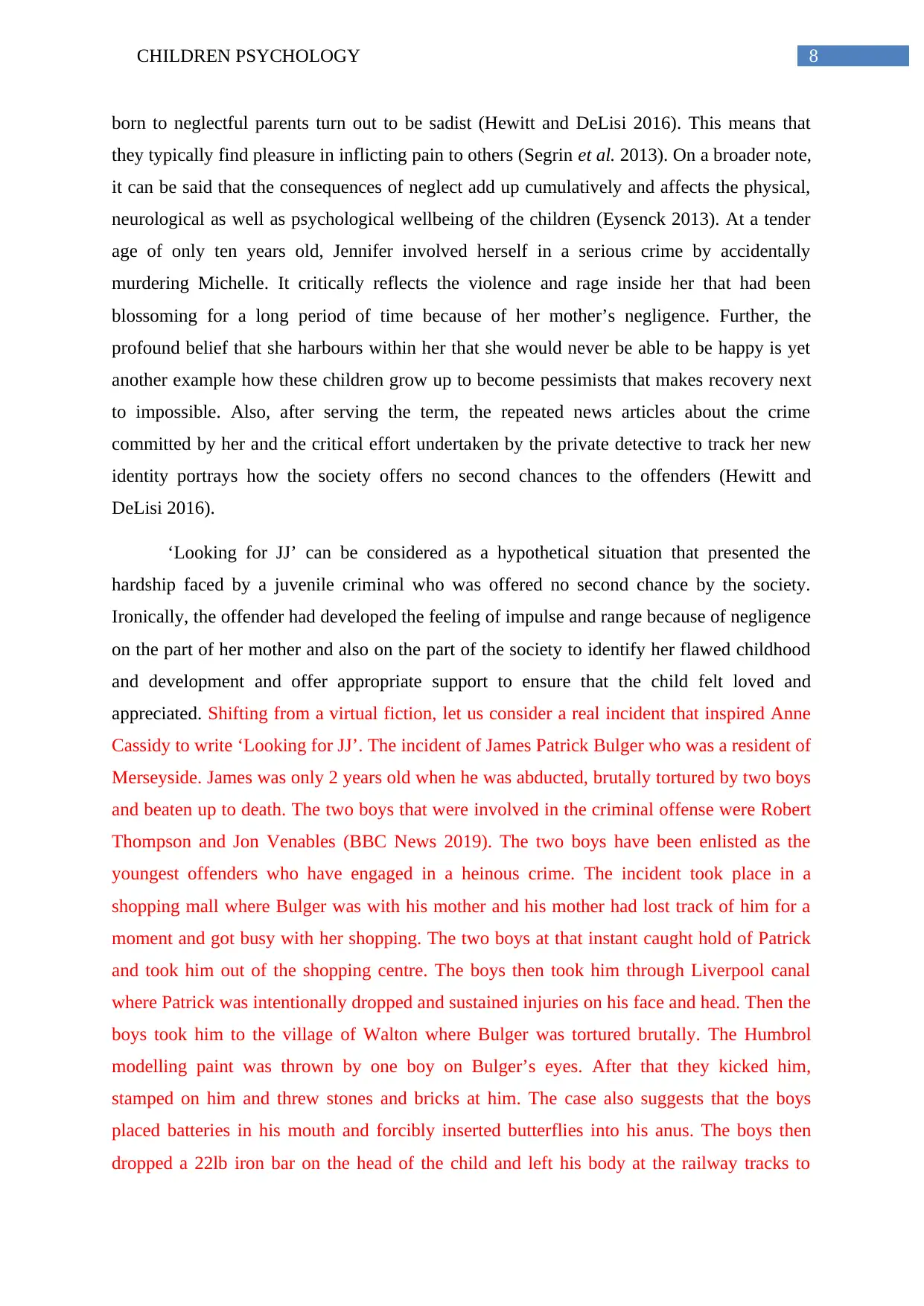
8CHILDREN PSYCHOLOGY
born to neglectful parents turn out to be sadist (Hewitt and DeLisi 2016). This means that
they typically find pleasure in inflicting pain to others (Segrin et al. 2013). On a broader note,
it can be said that the consequences of neglect add up cumulatively and affects the physical,
neurological as well as psychological wellbeing of the children (Eysenck 2013). At a tender
age of only ten years old, Jennifer involved herself in a serious crime by accidentally
murdering Michelle. It critically reflects the violence and rage inside her that had been
blossoming for a long period of time because of her mother’s negligence. Further, the
profound belief that she harbours within her that she would never be able to be happy is yet
another example how these children grow up to become pessimists that makes recovery next
to impossible. Also, after serving the term, the repeated news articles about the crime
committed by her and the critical effort undertaken by the private detective to track her new
identity portrays how the society offers no second chances to the offenders (Hewitt and
DeLisi 2016).
‘Looking for JJ’ can be considered as a hypothetical situation that presented the
hardship faced by a juvenile criminal who was offered no second chance by the society.
Ironically, the offender had developed the feeling of impulse and range because of negligence
on the part of her mother and also on the part of the society to identify her flawed childhood
and development and offer appropriate support to ensure that the child felt loved and
appreciated. Shifting from a virtual fiction, let us consider a real incident that inspired Anne
Cassidy to write ‘Looking for JJ’. The incident of James Patrick Bulger who was a resident of
Merseyside. James was only 2 years old when he was abducted, brutally tortured by two boys
and beaten up to death. The two boys that were involved in the criminal offense were Robert
Thompson and Jon Venables (BBC News 2019). The two boys have been enlisted as the
youngest offenders who have engaged in a heinous crime. The incident took place in a
shopping mall where Bulger was with his mother and his mother had lost track of him for a
moment and got busy with her shopping. The two boys at that instant caught hold of Patrick
and took him out of the shopping centre. The boys then took him through Liverpool canal
where Patrick was intentionally dropped and sustained injuries on his face and head. Then the
boys took him to the village of Walton where Bulger was tortured brutally. The Humbrol
modelling paint was thrown by one boy on Bulger’s eyes. After that they kicked him,
stamped on him and threw stones and bricks at him. The case also suggests that the boys
placed batteries in his mouth and forcibly inserted butterflies into his anus. The boys then
dropped a 22lb iron bar on the head of the child and left his body at the railway tracks to
born to neglectful parents turn out to be sadist (Hewitt and DeLisi 2016). This means that
they typically find pleasure in inflicting pain to others (Segrin et al. 2013). On a broader note,
it can be said that the consequences of neglect add up cumulatively and affects the physical,
neurological as well as psychological wellbeing of the children (Eysenck 2013). At a tender
age of only ten years old, Jennifer involved herself in a serious crime by accidentally
murdering Michelle. It critically reflects the violence and rage inside her that had been
blossoming for a long period of time because of her mother’s negligence. Further, the
profound belief that she harbours within her that she would never be able to be happy is yet
another example how these children grow up to become pessimists that makes recovery next
to impossible. Also, after serving the term, the repeated news articles about the crime
committed by her and the critical effort undertaken by the private detective to track her new
identity portrays how the society offers no second chances to the offenders (Hewitt and
DeLisi 2016).
‘Looking for JJ’ can be considered as a hypothetical situation that presented the
hardship faced by a juvenile criminal who was offered no second chance by the society.
Ironically, the offender had developed the feeling of impulse and range because of negligence
on the part of her mother and also on the part of the society to identify her flawed childhood
and development and offer appropriate support to ensure that the child felt loved and
appreciated. Shifting from a virtual fiction, let us consider a real incident that inspired Anne
Cassidy to write ‘Looking for JJ’. The incident of James Patrick Bulger who was a resident of
Merseyside. James was only 2 years old when he was abducted, brutally tortured by two boys
and beaten up to death. The two boys that were involved in the criminal offense were Robert
Thompson and Jon Venables (BBC News 2019). The two boys have been enlisted as the
youngest offenders who have engaged in a heinous crime. The incident took place in a
shopping mall where Bulger was with his mother and his mother had lost track of him for a
moment and got busy with her shopping. The two boys at that instant caught hold of Patrick
and took him out of the shopping centre. The boys then took him through Liverpool canal
where Patrick was intentionally dropped and sustained injuries on his face and head. Then the
boys took him to the village of Walton where Bulger was tortured brutally. The Humbrol
modelling paint was thrown by one boy on Bulger’s eyes. After that they kicked him,
stamped on him and threw stones and bricks at him. The case also suggests that the boys
placed batteries in his mouth and forcibly inserted butterflies into his anus. The boys then
dropped a 22lb iron bar on the head of the child and left his body at the railway tracks to
⊘ This is a preview!⊘
Do you want full access?
Subscribe today to unlock all pages.

Trusted by 1+ million students worldwide
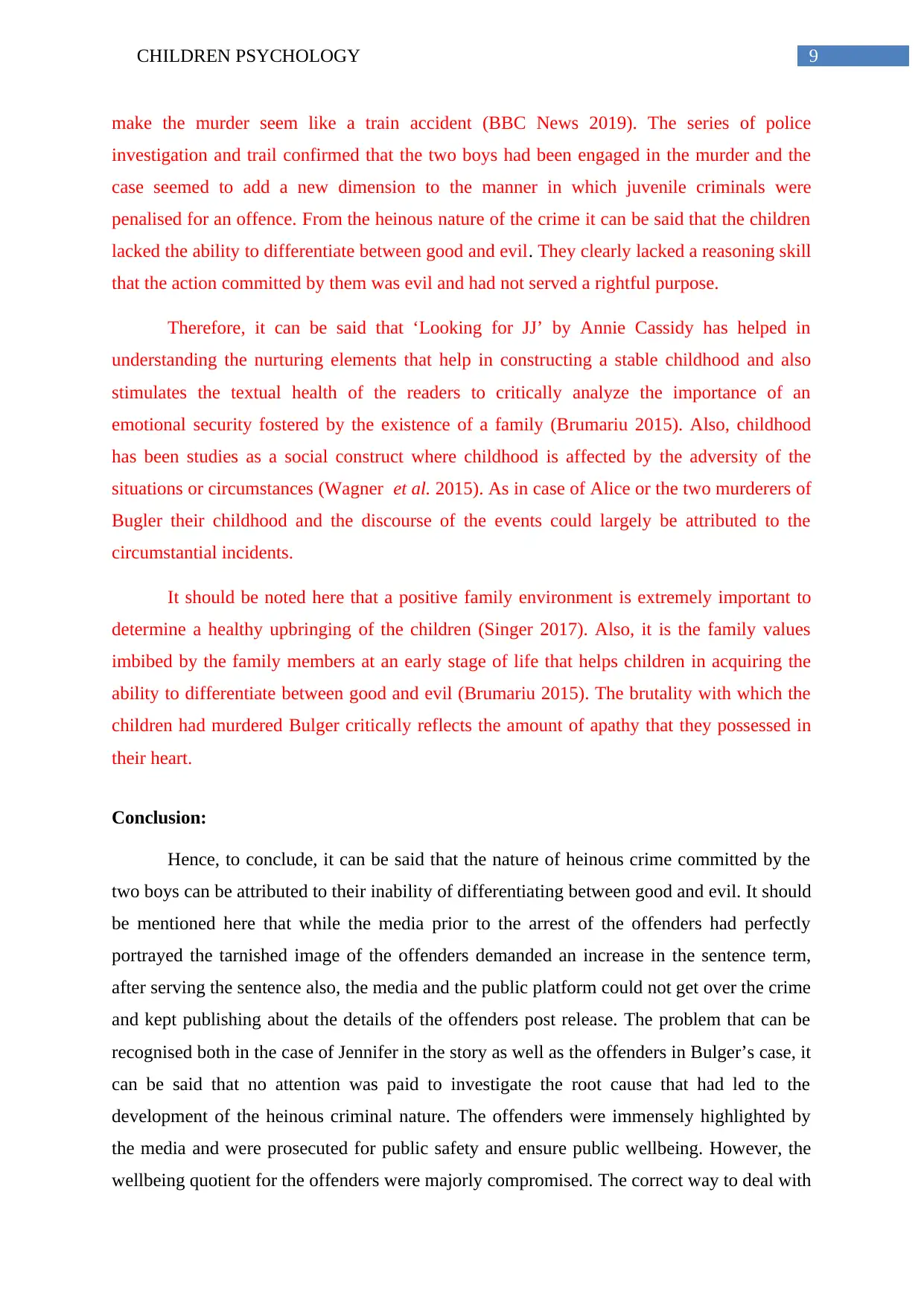
9CHILDREN PSYCHOLOGY
make the murder seem like a train accident (BBC News 2019). The series of police
investigation and trail confirmed that the two boys had been engaged in the murder and the
case seemed to add a new dimension to the manner in which juvenile criminals were
penalised for an offence. From the heinous nature of the crime it can be said that the children
lacked the ability to differentiate between good and evil. They clearly lacked a reasoning skill
that the action committed by them was evil and had not served a rightful purpose.
Therefore, it can be said that ‘Looking for JJ’ by Annie Cassidy has helped in
understanding the nurturing elements that help in constructing a stable childhood and also
stimulates the textual health of the readers to critically analyze the importance of an
emotional security fostered by the existence of a family (Brumariu 2015). Also, childhood
has been studies as a social construct where childhood is affected by the adversity of the
situations or circumstances (Wagner et al. 2015). As in case of Alice or the two murderers of
Bugler their childhood and the discourse of the events could largely be attributed to the
circumstantial incidents.
It should be noted here that a positive family environment is extremely important to
determine a healthy upbringing of the children (Singer 2017). Also, it is the family values
imbibed by the family members at an early stage of life that helps children in acquiring the
ability to differentiate between good and evil (Brumariu 2015). The brutality with which the
children had murdered Bulger critically reflects the amount of apathy that they possessed in
their heart.
Conclusion:
Hence, to conclude, it can be said that the nature of heinous crime committed by the
two boys can be attributed to their inability of differentiating between good and evil. It should
be mentioned here that while the media prior to the arrest of the offenders had perfectly
portrayed the tarnished image of the offenders demanded an increase in the sentence term,
after serving the sentence also, the media and the public platform could not get over the crime
and kept publishing about the details of the offenders post release. The problem that can be
recognised both in the case of Jennifer in the story as well as the offenders in Bulger’s case, it
can be said that no attention was paid to investigate the root cause that had led to the
development of the heinous criminal nature. The offenders were immensely highlighted by
the media and were prosecuted for public safety and ensure public wellbeing. However, the
wellbeing quotient for the offenders were majorly compromised. The correct way to deal with
make the murder seem like a train accident (BBC News 2019). The series of police
investigation and trail confirmed that the two boys had been engaged in the murder and the
case seemed to add a new dimension to the manner in which juvenile criminals were
penalised for an offence. From the heinous nature of the crime it can be said that the children
lacked the ability to differentiate between good and evil. They clearly lacked a reasoning skill
that the action committed by them was evil and had not served a rightful purpose.
Therefore, it can be said that ‘Looking for JJ’ by Annie Cassidy has helped in
understanding the nurturing elements that help in constructing a stable childhood and also
stimulates the textual health of the readers to critically analyze the importance of an
emotional security fostered by the existence of a family (Brumariu 2015). Also, childhood
has been studies as a social construct where childhood is affected by the adversity of the
situations or circumstances (Wagner et al. 2015). As in case of Alice or the two murderers of
Bugler their childhood and the discourse of the events could largely be attributed to the
circumstantial incidents.
It should be noted here that a positive family environment is extremely important to
determine a healthy upbringing of the children (Singer 2017). Also, it is the family values
imbibed by the family members at an early stage of life that helps children in acquiring the
ability to differentiate between good and evil (Brumariu 2015). The brutality with which the
children had murdered Bulger critically reflects the amount of apathy that they possessed in
their heart.
Conclusion:
Hence, to conclude, it can be said that the nature of heinous crime committed by the
two boys can be attributed to their inability of differentiating between good and evil. It should
be mentioned here that while the media prior to the arrest of the offenders had perfectly
portrayed the tarnished image of the offenders demanded an increase in the sentence term,
after serving the sentence also, the media and the public platform could not get over the crime
and kept publishing about the details of the offenders post release. The problem that can be
recognised both in the case of Jennifer in the story as well as the offenders in Bulger’s case, it
can be said that no attention was paid to investigate the root cause that had led to the
development of the heinous criminal nature. The offenders were immensely highlighted by
the media and were prosecuted for public safety and ensure public wellbeing. However, the
wellbeing quotient for the offenders were majorly compromised. The correct way to deal with
Paraphrase This Document
Need a fresh take? Get an instant paraphrase of this document with our AI Paraphraser
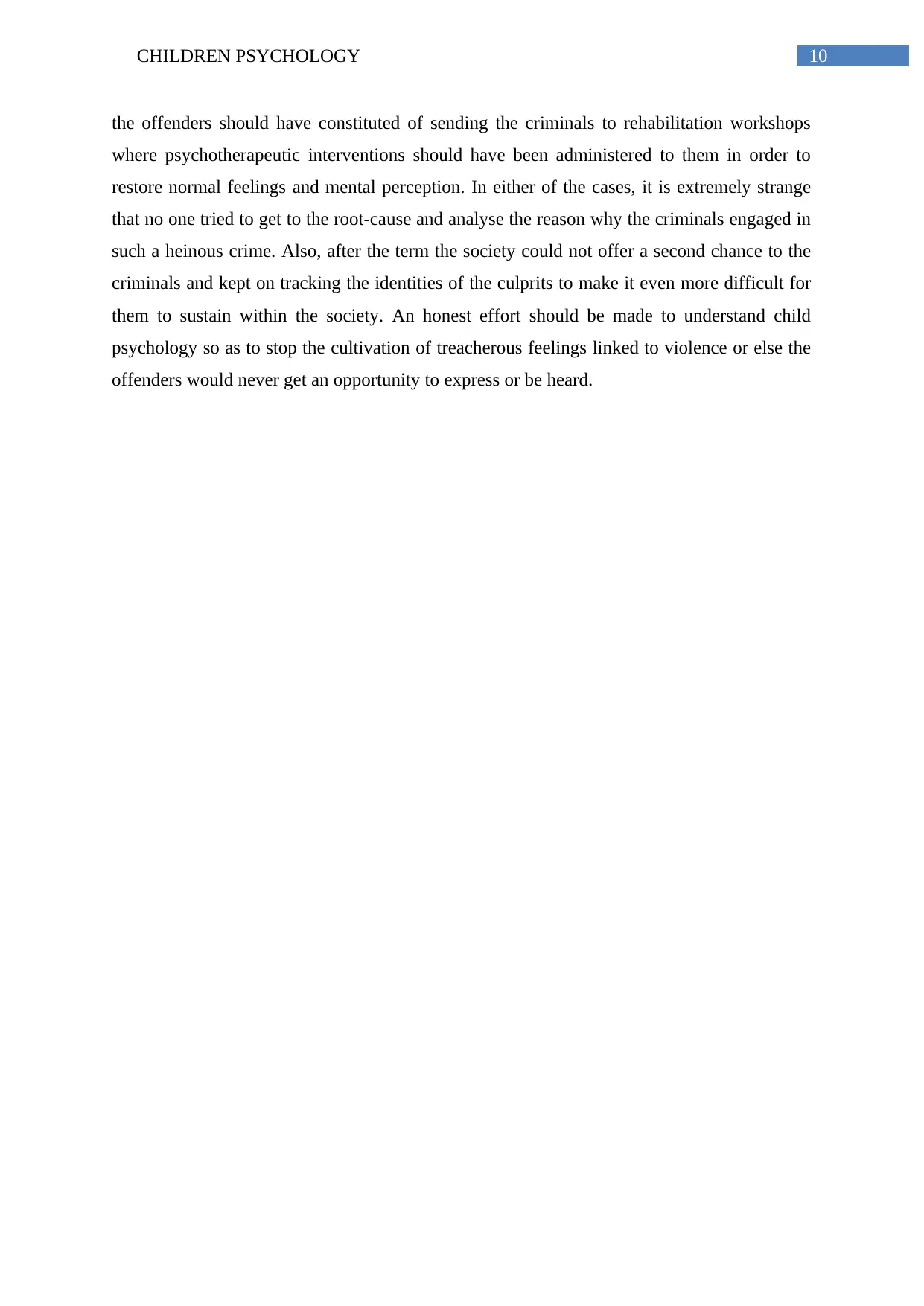
10CHILDREN PSYCHOLOGY
the offenders should have constituted of sending the criminals to rehabilitation workshops
where psychotherapeutic interventions should have been administered to them in order to
restore normal feelings and mental perception. In either of the cases, it is extremely strange
that no one tried to get to the root-cause and analyse the reason why the criminals engaged in
such a heinous crime. Also, after the term the society could not offer a second chance to the
criminals and kept on tracking the identities of the culprits to make it even more difficult for
them to sustain within the society. An honest effort should be made to understand child
psychology so as to stop the cultivation of treacherous feelings linked to violence or else the
offenders would never get an opportunity to express or be heard.
the offenders should have constituted of sending the criminals to rehabilitation workshops
where psychotherapeutic interventions should have been administered to them in order to
restore normal feelings and mental perception. In either of the cases, it is extremely strange
that no one tried to get to the root-cause and analyse the reason why the criminals engaged in
such a heinous crime. Also, after the term the society could not offer a second chance to the
criminals and kept on tracking the identities of the culprits to make it even more difficult for
them to sustain within the society. An honest effort should be made to understand child
psychology so as to stop the cultivation of treacherous feelings linked to violence or else the
offenders would never get an opportunity to express or be heard.
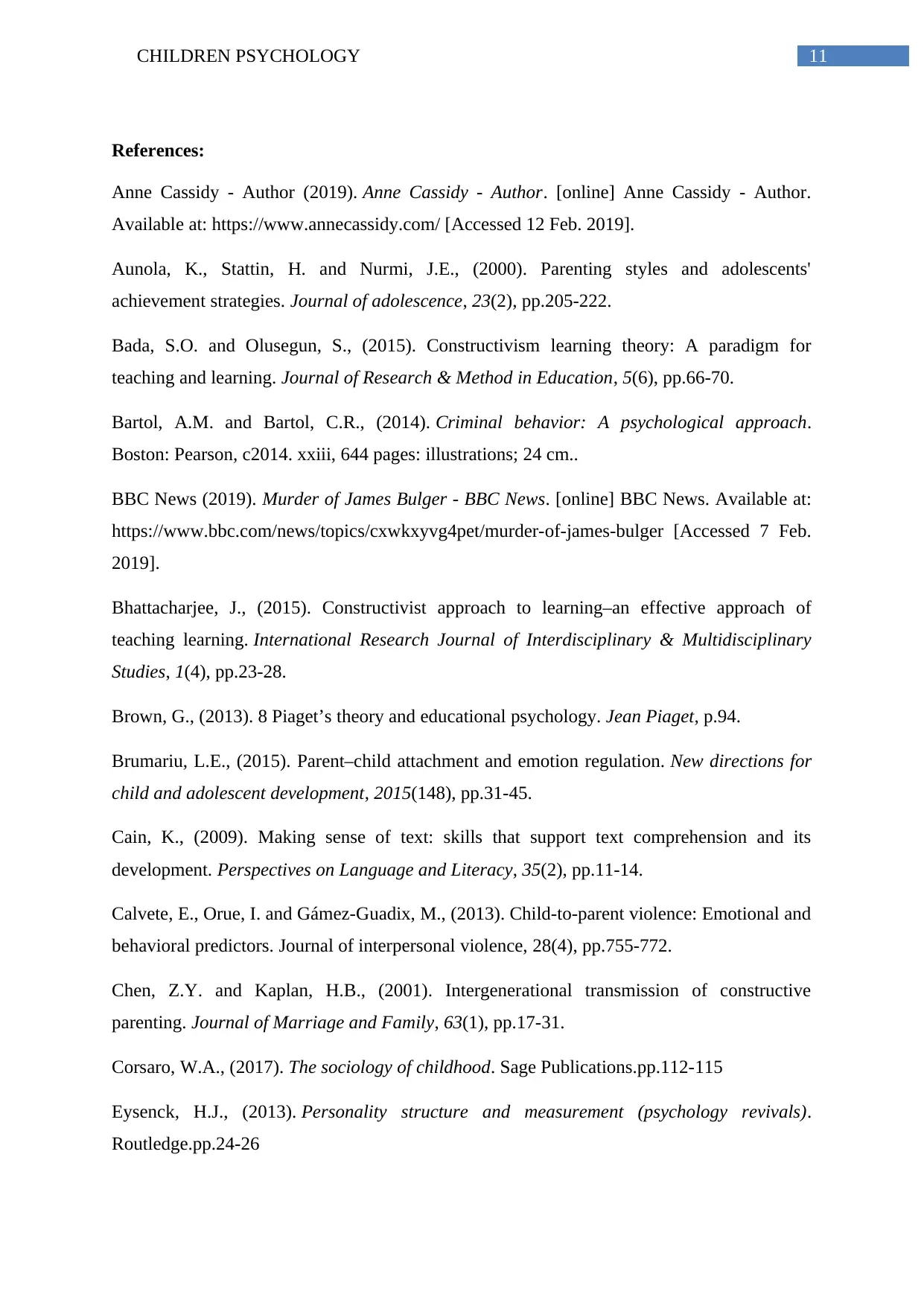
11CHILDREN PSYCHOLOGY
References:
Anne Cassidy - Author (2019). Anne Cassidy - Author. [online] Anne Cassidy - Author.
Available at: https://www.annecassidy.com/ [Accessed 12 Feb. 2019].
Aunola, K., Stattin, H. and Nurmi, J.E., (2000). Parenting styles and adolescents'
achievement strategies. Journal of adolescence, 23(2), pp.205-222.
Bada, S.O. and Olusegun, S., (2015). Constructivism learning theory: A paradigm for
teaching and learning. Journal of Research & Method in Education, 5(6), pp.66-70.
Bartol, A.M. and Bartol, C.R., (2014). Criminal behavior: A psychological approach.
Boston: Pearson, c2014. xxiii, 644 pages: illustrations; 24 cm..
BBC News (2019). Murder of James Bulger - BBC News. [online] BBC News. Available at:
https://www.bbc.com/news/topics/cxwkxyvg4pet/murder-of-james-bulger [Accessed 7 Feb.
2019].
Bhattacharjee, J., (2015). Constructivist approach to learning–an effective approach of
teaching learning. International Research Journal of Interdisciplinary & Multidisciplinary
Studies, 1(4), pp.23-28.
Brown, G., (2013). 8 Piaget’s theory and educational psychology. Jean Piaget, p.94.
Brumariu, L.E., (2015). Parent–child attachment and emotion regulation. New directions for
child and adolescent development, 2015(148), pp.31-45.
Cain, K., (2009). Making sense of text: skills that support text comprehension and its
development. Perspectives on Language and Literacy, 35(2), pp.11-14.
Calvete, E., Orue, I. and Gámez-Guadix, M., (2013). Child-to-parent violence: Emotional and
behavioral predictors. Journal of interpersonal violence, 28(4), pp.755-772.
Chen, Z.Y. and Kaplan, H.B., (2001). Intergenerational transmission of constructive
parenting. Journal of Marriage and Family, 63(1), pp.17-31.
Corsaro, W.A., (2017). The sociology of childhood. Sage Publications.pp.112-115
Eysenck, H.J., (2013). Personality structure and measurement (psychology revivals).
Routledge.pp.24-26
References:
Anne Cassidy - Author (2019). Anne Cassidy - Author. [online] Anne Cassidy - Author.
Available at: https://www.annecassidy.com/ [Accessed 12 Feb. 2019].
Aunola, K., Stattin, H. and Nurmi, J.E., (2000). Parenting styles and adolescents'
achievement strategies. Journal of adolescence, 23(2), pp.205-222.
Bada, S.O. and Olusegun, S., (2015). Constructivism learning theory: A paradigm for
teaching and learning. Journal of Research & Method in Education, 5(6), pp.66-70.
Bartol, A.M. and Bartol, C.R., (2014). Criminal behavior: A psychological approach.
Boston: Pearson, c2014. xxiii, 644 pages: illustrations; 24 cm..
BBC News (2019). Murder of James Bulger - BBC News. [online] BBC News. Available at:
https://www.bbc.com/news/topics/cxwkxyvg4pet/murder-of-james-bulger [Accessed 7 Feb.
2019].
Bhattacharjee, J., (2015). Constructivist approach to learning–an effective approach of
teaching learning. International Research Journal of Interdisciplinary & Multidisciplinary
Studies, 1(4), pp.23-28.
Brown, G., (2013). 8 Piaget’s theory and educational psychology. Jean Piaget, p.94.
Brumariu, L.E., (2015). Parent–child attachment and emotion regulation. New directions for
child and adolescent development, 2015(148), pp.31-45.
Cain, K., (2009). Making sense of text: skills that support text comprehension and its
development. Perspectives on Language and Literacy, 35(2), pp.11-14.
Calvete, E., Orue, I. and Gámez-Guadix, M., (2013). Child-to-parent violence: Emotional and
behavioral predictors. Journal of interpersonal violence, 28(4), pp.755-772.
Chen, Z.Y. and Kaplan, H.B., (2001). Intergenerational transmission of constructive
parenting. Journal of Marriage and Family, 63(1), pp.17-31.
Corsaro, W.A., (2017). The sociology of childhood. Sage Publications.pp.112-115
Eysenck, H.J., (2013). Personality structure and measurement (psychology revivals).
Routledge.pp.24-26
⊘ This is a preview!⊘
Do you want full access?
Subscribe today to unlock all pages.

Trusted by 1+ million students worldwide
1 out of 14
Your All-in-One AI-Powered Toolkit for Academic Success.
+13062052269
info@desklib.com
Available 24*7 on WhatsApp / Email
![[object Object]](/_next/static/media/star-bottom.7253800d.svg)
Unlock your academic potential
Copyright © 2020–2025 A2Z Services. All Rights Reserved. Developed and managed by ZUCOL.